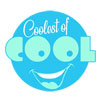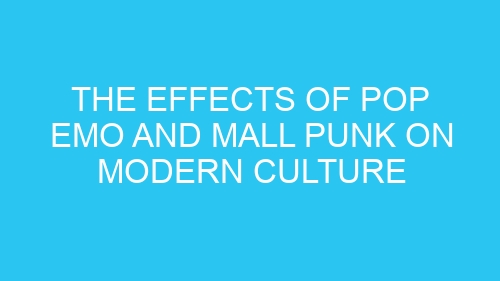-
Table of Contents
The Influence of Pop Emo and Mall Punk on Fashion Trends
Pop Emo and Mall Punk may have had their heyday in the early 2000s, but their influence on modern culture, particularly in the realm of fashion, is undeniable. These genres, with their catchy melodies and angsty lyrics, not only shaped the music scene but also left an indelible mark on the way we dress. So, let’s take a trip down memory lane and explore the lasting effects of Pop Emo and Mall Punk on fashion trends.
One of the most iconic fashion statements of the Pop Emo and Mall Punk era was undoubtedly the skinny jeans. These tight-fitting denim pants became a staple for both male and female fans of the genre. It was as if the music had somehow convinced us that our legs needed to be as suffocated as our emotions. And let’s not forget the countless hours spent trying to squeeze into those impossibly tight jeans, only to realize that breathing was now a luxury we couldn’t afford.
But skinny jeans were just the tip of the fashion iceberg. Pop Emo and Mall Punk also introduced us to a plethora of accessories that became synonymous with the scene. Who could forget the studded belts, wristbands, and fingerless gloves? These accessories were like armor, protecting us from the judgmental eyes of the world while simultaneously making it impossible to use our hands for anything practical. Need to open a door? Good luck with those fingerless gloves!
And let’s not overlook the influence of Pop Emo and Mall Punk on hair trends. Emo haircuts were all the rage, with their asymmetrical bangs and jet-black dye jobs. It was as if we were trying to visually represent the turmoil within our souls through our hairstyles. And if you were really committed to the look, you might even add some colorful streaks or a neon-colored fringe. Because nothing says “I’m an emotional wreck” like a head full of rainbow-colored hair.
But it wasn’t just the clothing and hairstyles that were affected by Pop Emo and Mall Punk. The music scene also gave birth to a new breed of footwear – the beloved Converse sneakers. These canvas shoes, often adorned with doodles and band logos, became the go-to choice for anyone wanting to show off their alternative music taste. And let’s be honest, they were also the perfect footwear for moshing at concerts or standing in line for hours to buy the latest album from your favorite band.
In addition to the fashion trends directly inspired by Pop Emo and Mall Punk, their influence can still be seen in modern-day streetwear. The DIY aesthetic, characterized by ripped jeans, band t-shirts, and patches, has become a staple of urban fashion. It’s as if we’re all still trying to hold on to that rebellious spirit, even if our angsty teenage years are long gone.
So, while Pop Emo and Mall Punk may have faded from the mainstream music scene, their impact on fashion trends is still felt today. From skinny jeans and studded belts to asymmetrical haircuts and Converse sneakers, these genres left an indelible mark on our wardrobes. And who knows, maybe one day we’ll look back at the fashion trends of today and wonder how we ever thought they were cool. But for now, let’s embrace the legacy of Pop Emo and Mall Punk and wear our skinny jeans with pride – even if we can’t breathe properly.
The Impact of Pop Emo and Mall Punk on Music and Subcultures
Pop Emo and Mall Punk may not be the most respected genres in the music industry, but there’s no denying their impact on modern culture. These genres, which emerged in the early 2000s, have left an indelible mark on music and subcultures. From their catchy hooks to their angsty lyrics, Pop Emo and Mall Punk have captured the hearts of many, while simultaneously shaping the way we view and experience music.
Let’s start with Pop Emo. This genre, characterized by its blend of pop melodies and emotional lyrics, has become a staple in the music industry. Bands like Fall Out Boy, Panic! at the Disco, and My Chemical Romance have dominated the charts with their infectious tunes and relatable lyrics. Who hasn’t belted out the chorus of “Sugar, We’re Goin Down” or shed a tear to the haunting melodies of “Welcome to the Black Parade”?
But Pop Emo’s influence goes beyond just the music. It has spawned an entire subculture of fans who proudly wear their heart-on-their-sleeve emotions. These fans, often referred to as “emo kids,” can be easily identified by their black attire, heavy eyeliner, and carefully disheveled hair. They gather at concerts, forming a tight-knit community where they can express their emotions freely and find solace in the music that speaks to their souls.
On the other hand, we have Mall Punk, a genre that emerged from the depths of suburban shopping malls. With its fast-paced, energetic sound and rebellious lyrics, Mall Punk quickly gained popularity among disenchanted teenagers. Bands like Blink-182, Sum 41, and Good Charlotte became the anthems of a generation that felt misunderstood and yearned for an escape from the monotony of everyday life.
Mall Punk not only influenced the music scene but also left its mark on fashion and attitude. The style associated with this genre is characterized by baggy jeans, band t-shirts, and skate shoes. Mall Punk kids could be found hanging out at the local mall, skateboarding in parking lots, and causing a ruckus wherever they went. They embodied a sense of rebellion and nonconformity that resonated with many young people.
The impact of Pop Emo and Mall Punk on modern culture can still be felt today. While the popularity of these genres may have waned over the years, their influence can be seen in the music of contemporary artists. Many current pop stars, such as Halsey and Machine Gun Kelly, have incorporated elements of Pop Emo and Mall Punk into their music, creating a fusion of genres that appeals to a wide audience.
Furthermore, the subcultures that emerged from these genres continue to thrive. Emo kids may have grown up, but their love for emotional music and expressive fashion has not diminished. They have found solace in online communities, where they can connect with like-minded individuals and share their love for all things emo.
In conclusion, Pop Emo and Mall Punk may not be everyone’s cup of tea, but their impact on modern culture cannot be denied. These genres have shaped the music industry, spawned subcultures, and influenced fashion and attitude. Whether you’re a die-hard fan or just appreciate the occasional catchy tune, there’s no denying the lasting effects of Pop Emo and Mall Punk on our society. So next time you find yourself singing along to a Pop Emo anthem or feeling the urge to rebel, remember the influence of these genres and embrace the unique culture they have created.
The Evolution of Pop Emo and Mall Punk in Mainstream Media
The Evolution of Pop Emo and Mall Punk in Mainstream Media
Ah, the glorious era of the early 2000s, when pop emo and mall punk ruled the airwaves and our angsty teenage hearts. It was a time of skinny jeans, studded belts, and questionable haircuts. But beyond the fashion choices, these genres had a profound impact on modern culture that still resonates today.
Let’s take a trip down memory lane and explore the evolution of pop emo and mall punk in mainstream media. Picture this: it’s the year 2002, and Avril Lavigne’s “Complicated” is blasting from every radio station. Suddenly, a wave of angst-ridden teenagers emerges, clad in Hot Topic merchandise and eyeliner. This was the birth of mall punk, a genre that combined catchy pop melodies with punk rock sensibilities.
Mall punk bands like Good Charlotte and Simple Plan became the voice of a generation, singing about heartbreak, rebellion, and the struggles of being a misunderstood teenager. Their music resonated with millions of young people who felt like outsiders, creating a sense of community and belonging.
But it wasn’t just the music that made an impact. Pop emo and mall punk also influenced fashion trends, with skinny jeans, band t-shirts, and Converse sneakers becoming staples of the scene. Suddenly, everyone wanted to look like a member of Fall Out Boy or My Chemical Romance, even if they couldn’t quite pull off the eyeliner.
As the popularity of pop emo and mall punk grew, so did their presence in mainstream media. Suddenly, these once niche genres were being featured in movies, TV shows, and even commercials. Remember that iconic scene in “The O.C.” where Seth Cohen declares his love for Death Cab for Cutie? That was a pivotal moment for pop emo, as it brought the genre into the homes of millions of viewers.
But it wasn’t all sunshine and rainbows for pop emo and mall punk. As the genres gained popularity, they also faced backlash from critics who dismissed them as shallow and manufactured. Some argued that the music lacked substance and was simply a marketing ploy to sell merchandise to impressionable teenagers.
However, the impact of pop emo and mall punk cannot be denied. These genres gave a voice to a generation of young people who felt misunderstood and marginalized. They provided an outlet for emotions that were often dismissed or ignored by mainstream culture. And let’s not forget the countless mixtapes that were exchanged between friends, each song carefully selected to express a specific feeling or sentiment.
Today, the legacy of pop emo and mall punk lives on. While the fashion trends may have evolved, the spirit of these genres can still be felt in the music of artists like Paramore, Panic! at the Disco, and Twenty One Pilots. Their lyrics continue to resonate with young people who are navigating the complexities of love, identity, and the pressures of society.
So, the next time you find yourself singing along to a pop emo anthem or reminiscing about your mall punk days, remember the impact these genres had on modern culture. They may have been dismissed as a passing fad, but their influence is still felt today. And who knows, maybe it’s time to dig out those skinny jeans and studded belts and relive the glory days of pop emo and mall punk.

